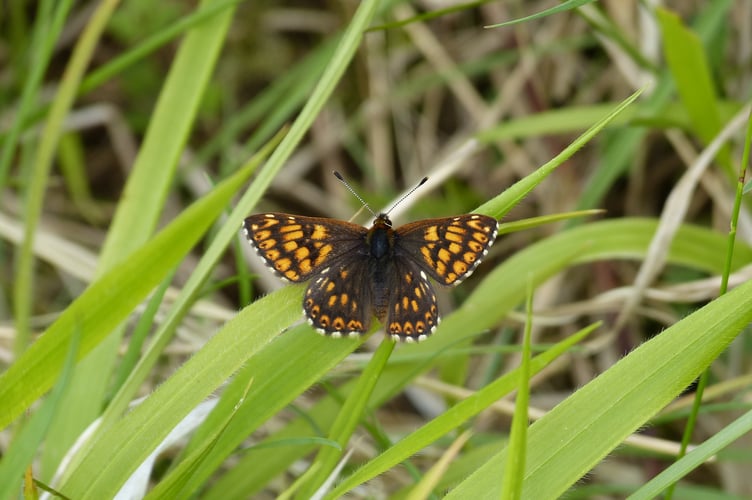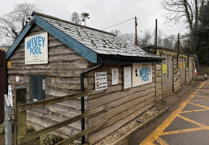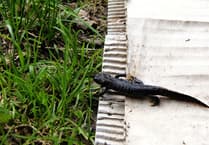FRITILLARIES are a spectacular group of butterflies within the family Nymphalidae. There are eight different species living in the UK, of which five can be found on Exmoor.
These butterflies are very distinctive, with orange-to-brown upper wings patterned with black lines and spots. The best way to identify the different species is by their underwings, which have distinctive patterns with white or silver streaks or patches.
They stand on only four of their six legs: their forelegs are much smaller and hairy. Their caterpillars, usually dark, with bristles, are very fussy about which plants they will eat.
Our local fritillaries include the Silver-washed Fritillary, almost the largest British butterfly, with a wingspan of 75mm. They fly from late June until early September. Horner Woods are a very good place to enjoy them.
.jpg?width=752&height=500&crop=752:500)
The male, a strong flyer, has bright orange upper wings with a distinctive pattern of black spots and lines. The female is duller and browner, but they both have distinctive under-wings with four silver streaks on a greenish background. The caterpillars feed on Dog Violets and hibernate over the winter.
The Dark Green Fritillary is another large British fritillary (wingspan averaging 66mm). It is in flight from mid-June to the end of August. This fritillary has similar markings to the Silver-washed on its upper wings but often with a greenish tinge.
It is clearly distinguishable, though, by having silver spots, rather than streaks, on its underwings. Dark Green Fritillaries are widespread in wild open areas, especially near the coast. The caterpillars feed on several species of violets.
.jpg?width=752&height=500&crop=752:500)
The High Brown Fritillary is is one of the rarest butterflies in the UK: the Heddon Valley area on Exmoor is one of its last strongholds. It is hard to distinguish from the Dark Green Fritillary, being of a similar size (wingspan 64mm) and frequenting similar areas at the same season
The main visual difference is a row of small blurred red eyes on the underwings. The caterpillars feed on Common Dog Violet in sunny sheltered areas.
In contrast with these three species, Small Pearl-bordered Fritillaries have a wing span of only 43 mm. They are in flight from the second half of May until mid-July. Sometimes they have a second brood in August. Again, the underwings are the key to identifying them.
The seven silver 'pearls' outlined in black around the hind-wing borders give them their name, the rest being a mosaic of silver, pale yellow and brown.

Their caterpillars also feed on violets. These dainty fritillaries may be found on scrubby valley sides such as those of the Exe below Exford.
The Heath Fritillary is another small butterfly, with a similar wingspan to the Small Pearl-Bordered (42 mm), again one of the rarest species in the UK.
This fritillary is of particular interest to the Exmoor Natural History Society as it was first discovered on Exmoor by our members Noel Allen and Roger Butcher in 1982 in the combes around Dunkery.
There are also colonies in Hawkcombe (where it was re-introduced in 2014) and on Grabbist Ridge above Alcombe. There is also a small colony on Haddon Hill.
.jpg?width=752&height=500&crop=752:500)
Heath Fritillaries, on the wing from early June until the end of July, normally live in separate colonies and do not fly far. They have a wingspan of 42mm and their upperwings are bright orange netted with fine black lines, with a border of white spots around the edges.
They can be seen basking in sunny patches near coppiced woodland. The main food plant of the caterpillars is common cow-wheat but they can also feed on ribwort plantain and foxgloves.
In some years these fritillaries have a hugely increased population and fly much further. This happened in 2023, when they were seen as far afield as Minehead and Porlock, with greatly increased numbers in their normal sites too. It will be interesting to see how this has affected their distribution and numbers this year.
.jpg?width=752&height=500&crop=752:500)
Butterfly Conservation, with the help mainly of the National Trust, has been monitoring and managing habitats in the South West to benefit the Heath Fritillary and the High-Brown Fritillary since 2005, with projects such as the Two Moors Project and All the Moors Project.
There is talk of re-introducing the Marsh Fritillary, only recently lost to Exmoor. Our Society has been monitoring the Heath Fritillary along with Butterfly Conservation since their discovery. Members send in records of what they have seen. Why not join us?
For more information about the work of the Exmoor Natural History Society visit www.enhs.org.uk





Comments
This article has no comments yet. Be the first to leave a comment.